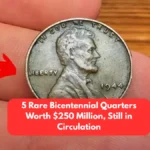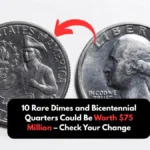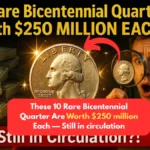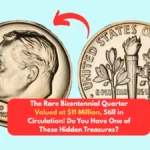Twenty-five cents are just pocket change for most people. But a few very rare Bicentennial quarters—quarters that were made in 1976 to honor America’s 200th birthday—are getting a lot of attention among coin collectors. In fact, some very rare copies of these quarters are thought to be worth as much as $94 million each.
It may sound impossible, but these coins are famous because of mistakes made during minting and strange events in history. The best part? You might not even know you have one of these in your pocket, in your change jar, or in the glove box.
Here’s why these five Bicentennial quarters are so expensive and how to tell if you’ve found real gold.
Why the Bicentennial Quarter Is Special
In 1976, the United States Mint created a commemorative quarter to mark 200 years of American independence. Unlike the standard design, which features an eagle, these special quarters display a colonial drummer with the dual date “1776–1976.” These were produced in two versions—one with a standard copper-nickel composition and another using 40% silver.
Even though the Mint produced hundreds of millions of these coins, making most of them very common, a small number possess distinctive traits or striking errors. These unusual characteristics have turned a few Bicentennial quarters into highly valuable collector’s items.
5 Rare Bicentennial Quarters Worth Millions
1. The 1976 Bicentennial Silver Proof Error Coin
Estimated Value: Up to $94 million
Why It’s Valuable: This coin was mistakenly struck on a 40% silver planchet and contains either a minting misprint or a die error.
Key Traits: Flawless proof strike, mirrored surface, and abnormal markings
Only a limited number of these error-laden silver proof coins are known to exist. Some numismatists suspect that more examples could be hiding in personal collections or simply misidentified. Their combination of rarity, striking appearance, and historical context makes them especially valuable, often fetching astronomical sums at auctions.
2. 1976 No Mint Mark Double Die Quarter
Estimated Value: $5 million–$10 million+
Why It’s Valuable: The doubling effect occurred during the minting process due to misalignment of the die.
Key Traits: Repetition of details on phrases like “IN GOD WE TRUST” and “LIBERTY”
Collectors have always been drawn to double die coins. The added appeal of a Bicentennial theme significantly boosts its worth. Those with clearly visible doubling are among the most prized, as this error was rare and generally caught before mass production.
3. 1976 San Francisco Silver Uncirculated Quarter with Off-Center Strike
Estimated Value: $1 million+
Why It’s Valuable: A minting misstep led to a silver coin being struck off-center.
Key Traits: Misaligned imagery, flawless uncirculated condition
This error created a dramatic misprint where the design is noticeably shifted. Being made from a 40% silver planchet and kept in pristine condition without entering circulation only increases its desirability. For collectors, this combination of factors adds up to major value.
4. 1976 Denver Bicentennial Quarter Struck on Wrong Planchet
Estimated Value: Up to $7 million
Why It’s Valuable: The coin was minted using an incorrect metal blank, possibly from another country or denomination.
Key Traits: Irregular weight, unexpected color or size
Occasionally, quarters were accidentally struck using planchets meant for other coins. If a Bicentennial quarter looks lighter, heavier, or off in color or size, it could be one of these rarities. These types of errors are among the most fascinating to collectors because they represent a clear and unexpected break from normal minting standards.
5. 1976 Bicentennial Quarter with Clad Layer Missing
Estimated Value: $250,000 to $2 million+
Why It’s Valuable: The absence of one clad layer exposes the coin’s copper interior.
Key Traits: One side appears copper-colored while the other looks normal
This error gives the coin a two-tone appearance, with one reddish-brown side standing out dramatically. It’s a result of a missing clad layer during production. Coins with this type of error are eye-catching and rare, making them especially valuable to collectors who appreciate minting anomalies.
How to Check If You Have One
You don’t need to be an expert in coin collecting to find a valuable Bicentennial quarter. A few simple checks can help you spot a potential treasure:
Start by checking the front of the coin for the dual date “1776–1976.” On the reverse, all genuine Bicentennial quarters feature a colonial drummer. Inspect the area near Washington’s hairline for a mint mark, such as “D” for Denver, “S” for San Francisco, or none for Philadelphia.
Weigh the coin—errors often result in a weight different from the standard 5.67 grams. Use a magnifying glass to check for doubling effects, off-center prints, or odd textures. And don’t forget to assess the color; any unusual hue like all-copper or full-silver could signal a rare error.
If something seems off or unique about your coin, do not spend it. Instead, take it to a professional coin dealer or submit it to grading organizations like PCGS or NGC for a full evaluation.
Final Thoughts: Treasure Could Be in Your Pocket
While the average Bicentennial quarter is worth just 25 cents, a small number are worth vast fortunes. These elusive coins sometimes appear in inherited coin collections, garage sales, or even tucked away in everyday change.
Spending a few extra minutes examining your quarters could lead to an extraordinary discovery. If you come across a Bicentennial coin with any of the rare traits described, it could be worth far more than you imagined.
Before you use your next quarter at a vending machine or laundry, take a moment to look closely. You just might be holding a small fortune in your hand without even realizing it.




